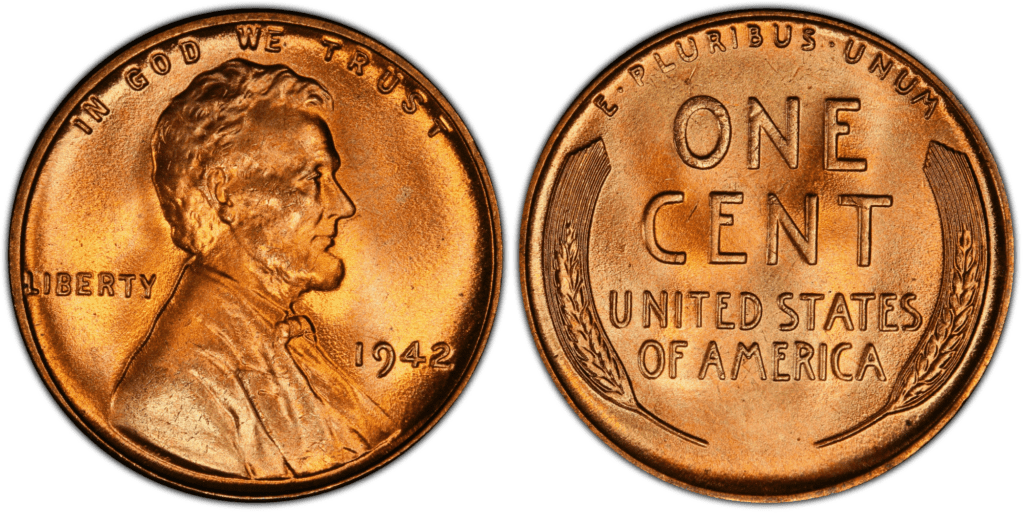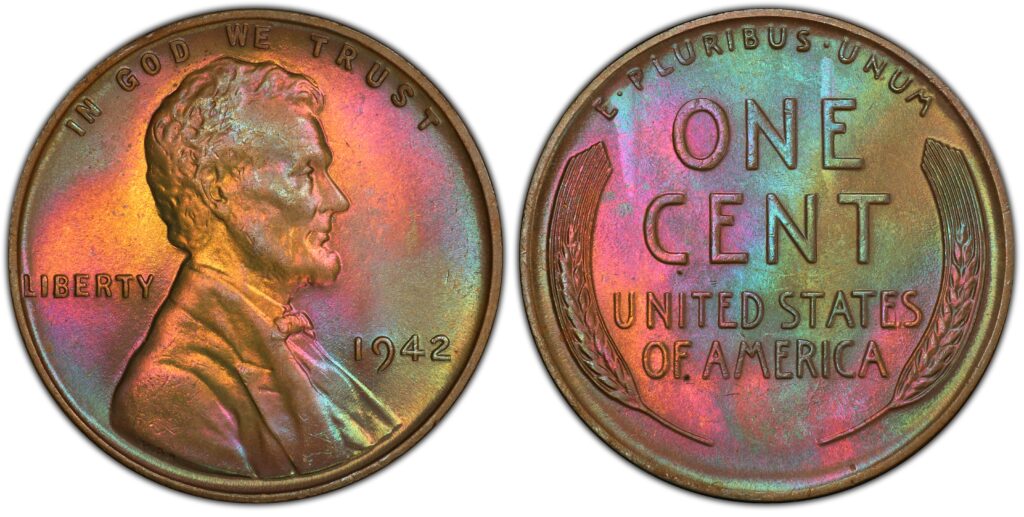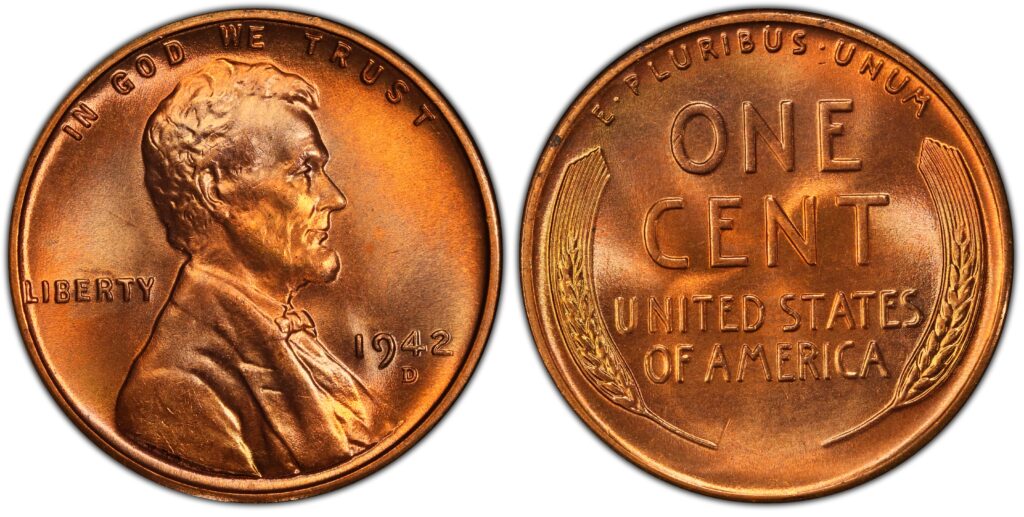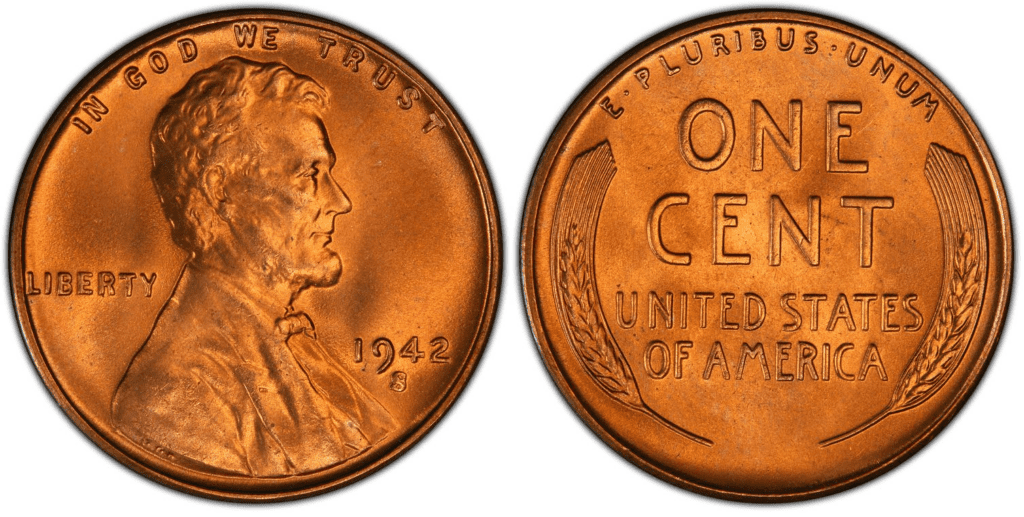What Is the 1942 Lincoln Wheat Penny Made Of?
Victor D. Brenner designed the 1942 Lincoln Wheat Penny, one of the one-cent coins struck for circulation from 1909 to 1958. It has a metal composition of 95% copper and 5% zinc and tin. The coin weighs approximately 3.11 grams and has a diameter of 19 mm.
That year, 864,579,590 coins were minted at three locations in the United States: Philadelphia, Denver, and San Francisco.

On the coin’s obverse, you can see Abraham Lincoln’s profile in the center, facing right. Inscriptions on the coin include the following:
- IN GOD WE TRUST
- LIBERTY
- 1942
The reverse includes the following inscriptions:
- E PLURIBUS UNUM
- ONE CENT
- UNITED STATES OF AMERICA
The reverse also features two individual stalks of wheat to the left and right of the central inscriptions, which helps explain why this coin is commonly called the “Wheat Penny.” In 1959, however, the Lincoln Memorial design replaced the wheat design.
1942 Lincoln Wheat Penny Varieties
We can find three varieties of the Lincoln Wheat Penny minted in 1942: the 1942-P Lincoln Penny, the 1942-D Lincoln Penny, and the 1942-S Lincoln Penny.
These pennies differ primarily in where they are struck. You can also differentiate them based on their mint marks. However, you should know that the 1942 Lincoln pennies from Philadelphia do not contain any mint marks.
Here is a summary of the Lincoln wheat pennies produced in 1942:
| Variety | Location | Mintage |
| 1942-P Lincoln Penny | Philadelphia | 657,796,000 |
| 1942-D Lincoln Penny | Denver | 206, 698,000 |
| 1942-S Lincoln Penny | San Francisco | 85,590,000 |
| Proof | Philadelphia | 32,600 |
| Total | 950,116,600 |
1942 P Lincoln Wheat Penny
Edge: Reeded
Mint Mark: no mintmark
Place of minting: Philadelphia
Year of minting: 1942
Face Value: $0.01 (one cent)
Price: $8 to $26 (or more)
Quantity produced: 657,796,000
Designer: Victor D. Brenner
Composition: 95% copper and 5% tin and zinc
Mass: 3.11 grams
Diameter: 19 mm

1942 was the sixth-highest production year for wheat cents struck in Philadelphia, with a total mintage of 657,796,000. These are currently considered to be Abundant on a rarity scale due to a massive mintage, obtainable in various states, from well-worn to Mint State.
Bright color and little abrasions are characteristics of desirable mint state coins. Circulated coins with wear are desirable if wear is minimal and Lincoln’s profile is well-detailed. Look closely at his bow tie; if you can see all four edges, it likely belongs to a circulated set and is a coveted coin.
Because so many rolls were kept at the time, this high mintage issue is fairly common in fully red gem condition. Even more, coins would have been minted, but copper was limited to aid the war effort. Tin was mostly omitted from this year’s cent manufacturing because it was already in short supply and had no impact on the coins’ look or wearability. Specialists look for two nice doubled-die obverse variations.
1942 D Lincoln Wheat Penny
Edge: Smooth
Mint Mark: D
Place of minting: Denver
Year of minting: 1942
Face Value: $0.01 (one cent)
Price: $9 to $25 (or more)
Quantity produced: 206,698,000
Designer: Victor D. Brenner
Composition: 95% copper and 5% tin and zinc
Mass: 3.11 grams
Diameter: 19 mm

On a rarity scale, the 1942 Lincoln wheat penny from Denver is considered Abundant, meaning many still exist today. As such, there is a demand for attractive examples with little to no wear. Although circulated coins suit the demands of young and starting collectors, upper-grade coins are included in higher-end collections.
The Denver Mint’s huge 1942 mintage of cents was insufficient to satisfy commercial demands. Millions of earlier cents were widely believed to be idle due to unintentional hoarding, particularly during the holiday season.
The majority of 1942-D Lincoln wheat pennies were rather nicely produced. However, the increased output did result in some die misuse. Collectors will therefore need to choose sharply struck coins with care.
1942 S Lincoln Wheat Penny
Edge: Smooth
Mint Mark: S
Place of minting: San Francisco
Year of minting: 1942
Face Value: $0.01 (one cent)
Price: $8 to $26 (or more)
Quantity produced: 85,590,000
Designer: Victor D. Brenner
Composition: 95% copper and 5% tin and zinc
Mass: 3.11 grams
Diameter: 19 mm

The fact that San Francisco earned the fewest 1942 cents brought attention to the variety. This coin is the last copper wheat cent to gain significant value upon discovery in better-than-average conditions. After repeated use, the majority displayed noticeable wear. It is desirable for collectors to assemble circulation sets in Extremely Fine and higher grades.
In early 1942, the long suspension of cent coinage at San Francisco during 1941 was still being overcome. During this time, mints were made solely in the said location until March. The production of the 1942-S Lincoln wheat pennies also gradually dwindled until the rest of the year because of restrictions on the use of copper.
The 1942-S Lincoln wheat penny frequently lacks the bright and flamboyant appearance that coin collectors prefer in favor of a more subdued red hue. For a long time, this issue was considered significantly harder to find than other high-grade 1940s cents. There are many repunched mintmark variations for 1942-S, most of them very insignificant. One is also joined with an obverse made from two dies.
List Of 1942 Lincoln Wheat Penny Errors
A coin that appears faulty or broken is useless to the typical person. But in the field of numismatics (the study, collection, and dealing of coins), an imperfection can drive up the cost of a coin by thousands of dollars! Let’s investigate the worth and reliability of a few 1942 wheat penny errors.
- Doubled Die error (DDO) error – This happens when the die moves while the coin is being hubbed, causing some features to double or shadow one another. Lincoln’s eyelid is doubled on one 1942 wheat penny, which sold for $150 in AU 53. A separate DDO sample, however, can bring in $250 in AU 53 and $500 in MS 63 and is visible on Liberty.
- DDO + RPM error – RPM means repunched mint mark. This could be the same mint mark (commonly denoted as D/D or S/S) imprinted on top of itself, such as D for Denver. Or it can be an S/D mixed mint mark error, which has an S over a D. This mistake occurs when recycled coins are transported between mints. MS 65 sells a wheat penny with DDO and RPM for $500.
- S/S/S RPM error – You can obtain $200 to $300 in excellent grades if your coin has a repunched mint mark fault. However, the value of coins with RPMs and DDOs increases. The word God (from the phrase In God We Trust) and the number 9 in 1942 are both DDOs on this 1942 wheat cent. Additionally, it bears a three-time re-punched San Francisco mint mark. It resold for approximately $1,000 in MS 66+ RD.
- D/D error – Repunched mint marks can occasionally be verified with a jeweler’s loupe or a coin microscope because the stamp is always clear. An MS 62 BN D/D coin sells for $150. The coin costs $700 in the better grade of MS 67 RD. The BN stands for Brown and is the third-best coin grade behind RD (red) and RBN (reddish-brown).
- Struck on a Thick Planchet error – We assume that coin mistakes can be seen visually. However, occasionally the coin appears perfect, and you won’t notice the inaccuracy unless you weigh it. This coin weighs 4.11g instead of 3.11g because it was produced on a thicker planchet. In MS 62 BN, the extra thickness gave some value to the coin, and it sold for more than $1,600.
- Obverse Struck Through error – A strikethrough error occurs when a foreign object comes into contact with the coin as it is being struck. Occasionally, it’s obvious, like a staple or a piece of tape. The piece that hit Lincoln’s eye in this instance was an egg-shaped fragment. The miscalculation increased the value of this 1942 wheat penny to $485 in AU 55 BN.
- Mirror Brockage Obverse 40% Off-Centre error – Because different dies are used for the obverse and reverse when coins are being made, mistakes frequently show on the side where the problematic die was used. However, sometimes the same mistake affects both sides of the issue. It’s known as a Brockage mistake. The top two-thirds of Abraham Lincoln’s head is visible on a coin with a 40% off-center brockage fault. The coin sold for more than $2,500 in MS 62 BN.
- Struck on a Brass Planchet error – A planchet is a blank metal disc onto which a die creates a coin. Planchets for the 1942 wheat cent were designed to be made of an alloy known as French bronze, composed of 95% copper and 5% zinc. The toning is unusual on this coin because it was struck on a brass planchet.
- Struck on a 10c Planchet error – Mint workers utilize enormous sheets with the proper weight and composition to construct a planchet. Therefore, if you use the incorrect sheet to punch your planchets, your coin may be stamped with the incorrect denomination. A penny (1c) struck on a dime (10c) will seem truncated and have a silvery finish. In EF 40, the coin sells for $1,000, but in AU 48, it sells for $14,000!
How Much Is The 1942 Lincoln Wheat Penny Worth Today?
Several different variables must be taken into consideration when estimating the nominal value of the 1942 Lincoln wheat penny. The coin’s condition is crucial. A coin’s value will be reduced if it is damaged. It also matters what kind of coin it is. Lincoln pennies were struck in up to three different varieties each year, so a coin’s type significantly impacts its value.
USA Coin Book, for instance, estimated the value of a 1942 Lincoln Wheat Penny at $0.20 in Average Condition. It may increase from $1.13 to $3.30 or more in Uncirculated (MS+) Mint Condition. Proof coins can be worth $45 or more.
How Does The Grading System Work?
The condition of a coin this old, like the 1942 Lincoln, is what collectors care about the most. Note that each Lincoln cent valuable enough for a collection will be graded for this reason.
You can grade the coin yourself or hire professional coin grading service providers like the Professional Coin Grading Service (PCGS) and the Numismatic Guaranty Corporation (NGC). Your coin’s value will rise significantly if it has received an official grade from these grading service providers.
An appraiser would consider the coin’s luster, color, preservation, strike, and attractiveness to assess its value and condition. Instruments like a microscope and a magnifying lens will be required to observe even the smallest detail of the coin.
Where To Buy Or Sell 1942 Lincoln Wheat Penny?
The most convenient way to purchase or sell 1942 Lincoln Wheat Pennies is online. Most vendors offer on sites like eBay, Etsy, and Amazon. If you’re fortunate, you might come across merchants selling their unique coins. Just be aware that they may be expensive if they’re high quality and in good condition.
However, the 1942 Lincoln Wheat Pennies can be sold or given to pawnshops or antique stores if you’d prefer to shop in person. Coin shops and auction houses are among your preferred locations.
Experts from PCGS and NGC can also guide you if you need advice on where and how to buy or sell your 1942 Lincoln Wheat Pennies.
FAQs
What is the error on the 1942 wheat penny?
The errors in the production of the 1942 Lincoln Wheat Penny include Doubled Die error (DDO) error, DDO + RPM error, S/S/S RPM error, D/D error, Struck on a Thick Planchet error, Obverse Struck Through error, Mirror Brockage Obverse 40% Off-Centre error, Struck on a Brass Planchet error, and Struck on a 10c Planchet error.
Where is the mint mark on a 1942 wheat penny?
You can find the “D” mint mark under the date in the 1942-D Lincoln Wheat Penny minted in Denver. In the same way, you can find the “S” mintmark under the date in the 1942-S Lincoln Wheat Penny minted in San Francisco. You can find no mint mark in the 1942 Lincoln Wheat Penny minted in Philadelphia.
How much is a 1942 wheat penny worth with no mint mark?
For this coin, you may receive 35 cents in average condition, but even in pristine condition, you would receive roughly $3 without flaws. However, a 1942 Wheat Penny Proof Coin (PF 67 RD CAM) without a mint mark sold for $17,000!
How much should a 1942 wheat penny weigh?
On average, the 1942 Lincoln Wheat Penny weighs 3.11 grams.
What Wheat Penny is worth $1000000?
The finest known 1943-S Lincoln Wheat penny on a bronze planchet cost collector Bob R. Simpson, co-chairman of the Texas Rangers baseball team, $1 million, according to Legend Numismatics of Lincroft, New Jersey, which was announced in September 2012.
